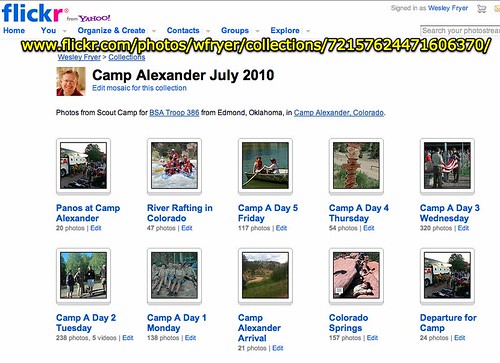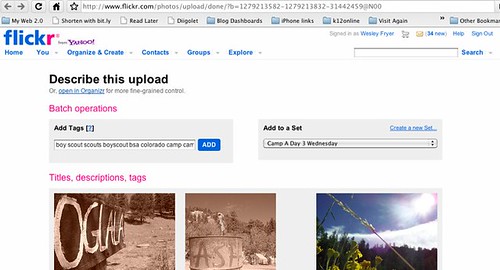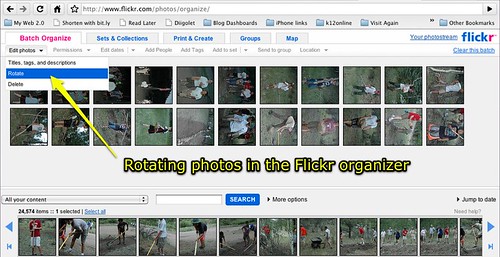Earlier this month, I had the privilege to accompany my son and his scout troop to summer camp in Colorado. Our group for the week included about 40 boys and 10 parents. Shortly after arriving at the church before our departure by charter bus, one of the other parents approached me and asked if I’d brought a laptop. I’m all for “disconnecting” and “unplugging” from technology at times, and I DID plan to do that at camp – but I also planned to do some writing on the “Powerful Ingredients 4 Blended Learning” project during the week. As a result, I brought my Dell Mini10 netbook along. Since I was the only person with a laptop on the trip, AND wifi was available in the Scoutmasters/adult leaders camp cabin, I become the designated storychaser for our trip. This meant I was the “go to” person for all the parents who were taking pictures of our scouts at camp and wanted to share them with the parents back home. In total, I think we had seven parents taking and submitting photos to me, all with different kinds of cameras and media storage cards. In addition, I took some videos with my iPhone 3GS and created a ten minute “highlights of summer camp” video which I edited and posted to YouTube right after we returned. DURING our time at summer camp, however, I uploaded almost one thousand photos to a Flickr collection I setup for the trip. In all, we collectively took and uploaded 1,136 photos of our boys’ summer camp experiences. I received good feedback from parents via email and in person during and after camp, that this provided a fun way for them to “follow along” in their own scout’s adventures at summer camp. In this post, I will share a bit about the process I followed uploading these photos, as well as some of my lessons learned storychasing summer camp.
To provide some organization to the large number of photos I knew I’d be uploading during the week of summer camp, I decided to organize our photos by day and upload them to Flickr into “sets” labeled by date. On my computer’s hard drive, I created folders for each parent’s full-size / uncompressed photos, and put those inside folders for each day. I kept track of which photos I had uploaded, because generally I was uploading 100 to 200 photos per day. This system worked pretty well.
Since we had parents using a wide variety of camera types with high resolutions, and our wifi connection from camp was “high speed” but still certainly limited in its upstream bandwidth, I needed a way to readily compress images before uploading them. This reduced the filesize of each image, making them upload faster, but still provided large images that are great to view and can even be used for small prints. I used the free Flickr Uploadr application, and in the app preferences chose to compress each image to a maximum of 1600 pixel width before uploading.
I have found it works best to upload photos with Flickr Uploadr in batches. Infrequently for some reason, an upload can “hang” or get stuck, and it can be necessary to start it again from the last photo not uploaded. The Uploadr program does quite a bit of processing of images too, when you choose NOT to upload full-quality images, and I’ve found it works faster if I upload smaller groups of photos rather than 100+ at a time. For my uploads from summer camp this year, I generally uploaded 50-60 images at a time. After each batch uploaded, Flickr Uploadr provides the option to put images in sets and add tags from the browser interface. It’s possible to do this in Uploadr first, but I found it easiest to just do this after each upload completed.
In the screenshot below, you can see tags I added to this particular batch of photos, as well as the Flickr set to which I wanted to add it.
The other post-uploading task I had to complete regularly was rotating images which were not taken vertically or in portrait view. I did this using the browser-based Flickr organizer. Again, I could have tried to find all the photos needing rotation in Flickr Uploadr prior to uploading, and rotated them there, but I found this easier to do in the browser afterward.
As I created new Flickr sets for each day, I added those to the Flickr collection I had created for the entire week. That way, our parents back home were able to simply check one site (the address for our Flickr collection) and view new photos which had been added there.
With hindsight, there are a few things I would have done differently and might do next time I have an opportunity to storychase a week-long event with the assistance of others.
- It would have been great to have a multi-format digital camera card reader along. While not everyone shooting photos during the week brought their own USB cable to connect their camera to a laptop, we were able to use the three USB cables we had and swap out memory cards into different cameras to copy everyone’s media to my hard drive. A card reader would have made this process even simpler, however.
- We didn’t give anyone “photo assignments” to make sure we covered all areas of camp activity and included all our boys in photos, but that might have been a good idea. With over 1000 photos taken, I think we did a pretty good job covering different aspects of camp, but it’s possible we missed some scouts or some activity areas. I’ll consider giving some “assignments” to storychaser photographers next time.
- For some reason my primary email address was not a “member” of our parent Yahoo group for our scout troop before camp, so when I uploaded new photos I relayed that to another parent back home who posted the news and link to the Yahoo group. Next time it would be good to be able to directly update our parent Yahoo group without going through an intermediary.
- Our troop has been working on a transition to a new WordPress site for the past six months, and that transition is not complete. As a result, we were not able to directly update the main homepage of our troop website from camp. It would be great to have direct access, via WordPress, to the site so we could have made updates there. That would make it easier for everyone back home (those in our Yahoo parent group and those who are not) to access our photos and videos.
- I’d definitely opt to bring a netbook to camp again. The small size, long battery life, and light weight made it ideal for my needs. There is no way I’d want to have a full size, 15″ laptop at camp. A netbook was perfect, and I’d definitely use one again.
We had a GREAT time at summer camp, and it was fun to be able to help share our experiences with parents back home during the week. I hope in the months ahead, our storychasers team will be able to share these kinds of methods / techniques with others making trips and wanting to document “in real time” those experiences for others back home. Next summer, I would love to help organize and lead a Storychasers travel event which would focus on learning things from the places we visit, but also developing these skills of digitally documenting and sharing events with others online.
If you have a group for which you’d like some formal “storychasing” professional development / workshops, please contact me or contact Storychasers directly.
Technorati Tags:
boy, digital, digitalstorytelling, edmond, oklahoma, photo, scout, storychase, storychasing, storytelling, summer, camp, boyscout, photography, troop380, colorado, alexander, campalexander
If you enjoyed this post and found it useful, subscribe to Wes’ free newsletter. Check out Wes’ video tutorial library, “Playing with Media.” Information about more ways to learn with Dr. Wesley Fryer are available on wesfryer.com/after.
On this day..
- Learning About Early Pottawatomie County, Kansas History – 2017
- Favorite iPad News Apps: July 2010 – 2010
- Exemplary Digital Stories from Hugo, Oklahoma – 2009
- Be wary of personal experience generalizations and don’t underestimate the power of your words – 2008
- A Quest for NetFlix Plus Functionality for Books – for Young Readers! – 2008
- links for 2008-07-24 – 2008
- Empowering Oklahoma Educators to Preserve and Share Oral History – 2008
- Outlook to iPhone sync process working – 2007
- Videoconferencing coming cell phones near you – 2007
- Sea change in our educational culture – 2006






